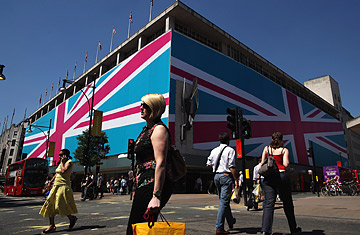
LONDON, ENGLAND - JULY 24: Members of the public walk past the John Lewis department store, where a giant Union Flag adorns it's facades, on Oxford Street on July 24, 2012 in London, England. London is gearing up with only 3 days remaining until the opening ceremony of the 2012 London Olympic games.
In Britain, big department stores tend to be as concerned about pedigree as the country's consumers. Ultra-posh stores like Harrods and Harvey Nichols cater to luxury lovers, while dowdier chains like BHS serve the budget-minded. But John Lewis, the country's largest and most successful department store, has become a national institution by doing both. At the 148-year-old chain, which has 29 department stores and eight smaller home stores around the country, members of the 1% drooling over $6,200 Maurice Lacroix crocodile-leather watches commingle with value shoppers angling for $31 unisex plastic Casios. Imagine wrapping a Bloomingdale's, Macy's and J.C. Penney into one in the U.S. "In class-conscious Britain, it manages to be fairly democratic," says Michael Poynor, founder of the consulting firm Retail Expertise. "No one is ashamed to be seen with a John Lewis bag."
John Lewis is such an entrenched cultural fixture that its nickname is the Bellwether of the High Street — a term commonly used to refer to Britain's Main Street. The high-low strategy has paid off throughout the recession even though the U.K.'s retail sales have been falling or flat since 2009 and shopping districts and malls are littered with vacant shops.
Through it all, John Lewis has maintained an unbroken 10-year streak of outsize sales growth. In an ailing economy, John Lewis' group sales — which include the department store and its upscale grocery chain, Waitrose — jumped 6.4% to a record $13.48 billion in its last fiscal year, besting competitors like Marks & Spencer and House of Fraser, whose sales rose a meager 2% and 1.5%, respectively. The company wasn't immune to the downturn: profits dipped nearly 9% to $607 million last year, partly because it invested more in its businesses. But the move didn't hurt sales, which surged 11% in the first 24 weeks of the year from the same period a year earlier.
One of John Lewis' secret weapons is its unusual structure: it's 100% owned by its 81,000 full-time employees. That makes its shareholders — who have a bigger stake in the company's success than floating shareholders of public companies — acutely focused on the long haul. "Our ownership model creates the right conditions for success," says Charlie Mayfield, John Lewis' chairman since 2007. Research shows that employee-owned businesses fare as well as or better than traditionally owned enterprises in good times and bad. They're more profitable, they create jobs faster than other companies, and they shed less staff, according to a recent study by London's Cass Business School. And they're outpacing rivals: business at worker-run shops is growing 50% faster than the British economy as a whole, according to new figures from the U.K. government. Amid news of exorbitant bonuses and a barrage of high-profile corporate scandals — Rupert Murdoch's phone-hacking scourge and Barclays' alleged interest-rate rigging being the latest — Downing Street has found a champion in John Lewis. Deputy Prime Minister Nick Clegg is amping up calls for a "John Lewis economy," one that encourages a more responsible brand of capitalism through employee-owned businesses. In July, days after the Barclays scandal broke, Clegg announced plans for a government office that will advise businesses on how to become employee run, along with tax breaks to sweeten the deal. Barclays, he said in a speech, is "a timely reminder that our economy desperately needs an injection of responsibility, greater checks on unaccountable power, power in more hands."
John Lewis employees — or partners, as they're called — don't actually own shares individually. They're held in a trust on their behalf. It's a profit-sharing arrangement, so when the company performs well, workers pocket a fat annual bonus. Last year it was worth 14% of their yearly salary, or roughly seven weeks' pay. Each store has an employee forum that elects representatives all the way up a food chain ending in a 14-member partnership board chaired by Mayfield, which meets four times a year. There, twice yearly, Mayfield puts his job up to a vote that could have him sacked. "And that's real power," says Mayfield, 47, who earned the same 14% bonus — for a total of $179,000 — as the rest of his staff last year. The equivalent bonus for Marc Bolland, CEO of Marks & Spencer, totaled $1.03 million.
Ceding power and pay is a lesson learned from the company's history. Founded by John Lewis as a curtain store in London in 1864, the shop quickly grew into a successful department store. As communist thinking spread in the early 20th century, John Spedan Lewis, the founder's son, began to fear for the business. He viewed the vast sums that his father, his brother and he earned — which totaled more than the pay of all their employees combined — as a tinderbox. The more reticent father shunted his son's designs on improving working conditions and doling out paid holidays, tasking him instead with turning around a smaller family-owned shop, the Peter Jones department store. When the elder Lewis died in 1928, Spedan Lewis took over the namesake store and set up an initial profit-sharing scheme. In 1950, he handed full ownership to the employees in a trust tied to a constitution. It touts the virtues of "worthwhile and satisfying employment" for the "happiness of all its members."
